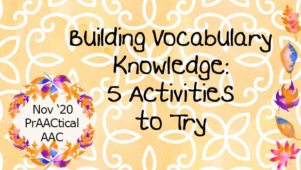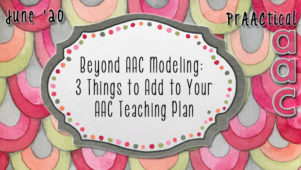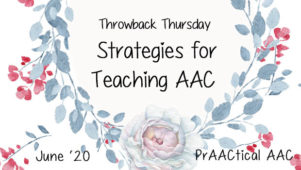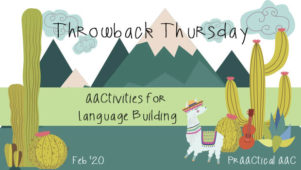Using Generalization Probes to Gauge Language Learning in AAC

In her role as the team’s SLP, Christy frequently collaborates with classroom teachers to identify areas of language development where students learning AAC need specific goals and instruction. Goals for her students address a range of areas.
- Given frequent aided language input, Evan will use 2-symbol sentences to make relevant comments at least twice per activity.
- When presented with preferred and non-preferred options, Sasha will independently request desired activities/objects with 70% accuracy.
- In the context of peer interactions, Tegan will ask a ‘What’ question in 3 out of 5 opportunities.
- Given gestural cues, Matthew will converse on a partner-selected topic for at least 4 conversational turns.
- With visual supports, Gabby will use subject + verb sentences to describe pictures, materials or events in 4 out of 6 trials.
To help the students acquire these skills, Christy carefully plans the instructional sequence and selects contexts appropriate for the intervention targets. She takes data regularly and uses it to adjust the intervention plan.
Her chief complaint? Even when students achieve these goals, they often fail to utilize those skills in day-to-day experiences.
- Sasha learned choice-making in activities such as free play with music/light-up/wind-up toys and snack. Even after she routinely chose preferred activities, toys, and people in those contexts, Sasha didn’t indicate preferences in play with other toys, or in more structured activities like art or music.
- Tegan got really good at asking ‘What’ his classmates brought for Sharing Time. But he never used that skill to ask ‘what’ they had at lunch, ‘what’ they wanted to do for recess, ‘what’ video game/TV show they like best, etc.
- Gabby became a champion at using 2-word (subject+verb) sentences to describe book illustrations in shared reading and answer teacher questions in Morning Meeting. In all other circumstances, though, she reverted back to communicating in single word responses.
We’ve written a good deal about promoting generalization (click here for a sampling of past posts). Here’s one more idea:
Use generalization probes in assessing skill development.
As we all know, response generalization refers to the individual’s ability to use a target skill in ways that are similar to what was directly taught but different in some respects. We want skills taught in certain ways to generalize to a variety of partners, places, topics, materials, and times of the day. One way we can support this is to probe for generalization when we are trying to gauge how well an individual has learned target skill. Generalization probes are assessment procedures that all us to determine whether the person is able to use the newly learned skill outside of the instructional context.
- For Sasha, who learned choice-making in activities with snack foods and music/light-up/wind-up toys, our generalization probes may include preferred and non-preferred musical instruments, art supplies, books and book props.
- Tegan developed his skill in asking ‘What’ questions in a supported conversation with a classmate. He was taught to ask ‘what’ the Student of the Week brought for Sharing Time. We can build generalization probes for Tegan and his friends around ‘what’ they want to do at recess, ‘what’ they ordered for hot lunch, ‘what’ book they picked for Reading Corner, etc.
- Gabby’s skill in using 2-word (subject+verb) sentences in Shared Reading and Morning Meeting can be assessed through generalization probes in various ways. We can stick with the same activities but change the condition. For example, in Shared Reading, rather than just describing book illustrations we can probe her ability to use these sentences to direct or describe the actions of others (e.g., You stop, Ms. Jessie go, I do).
Measuring the use of new skills in UNtrained conditions gives us important information about what we need to do next in order to help the learner become a more effective communicator in their daily lives.
We can use this information to adjust our teaching practices and develop new goals that support more frequent use of the new skills our AAC learners have acquired.
- In Sasha’s case, we introduced a greater variety of materials, communication partners, and classroom locations.
- For Tegan, support was provided to allow him to ask his friends ‘what’ questions on a greater range of topics and in different places around the school.
- Gabby’s team used least-to-most prompting to support subject + verb sentences for a broader range of communicative functions, such as giving instructions, retelling stories, and constructing personal narratives.
Generalization probes are a worthy addition to robust AAC intervention programs. They are not difficult to implement and can give us good instructional information that help us better support the functional communication and language development of AAC learners.
Do you use generalization probes in your AAC work? We’d love to hear about it.
Filed under: Featured Posts, PrAACtical Thinking
Tagged With: data dollection, generalization, language intervention
This post was written by Carole Zangari




